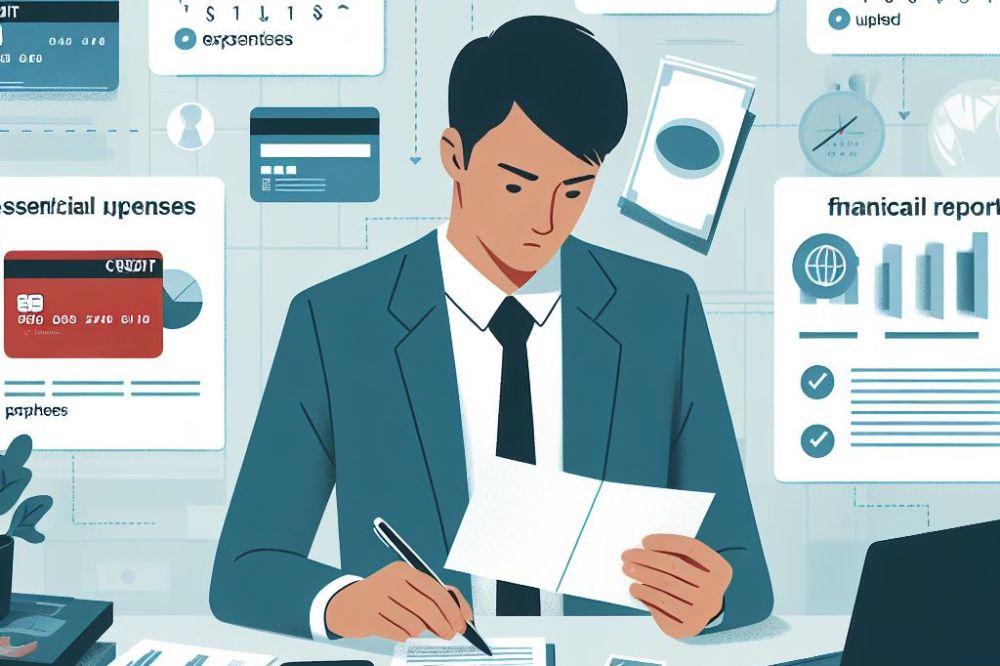- Key Takeaways
- Bankruptcy Basics Explained
- Types of Bankruptcy Filings
- Overview of the Bankruptcy Process
- Filing for Bankruptcy Steps
- Understanding Chapter 7 Bankruptcy
- Alternatives to Filing Bankruptcy
- Pros and Cons of Declaring Bankruptcy
- Rebuilding Your Finances After Bankruptcy
- Completing Debtor Education Course
- Final Remarks
- Frequently Asked Questions
Are you prepared to navigate the bankruptcy process with confidence and clarity? Understanding the ins and outs of this complex procedure is key to managing financial challenges effectively. From filing for bankruptcy to debt discharge, each step requires careful consideration and informed decision-making. Let’s delve into the intricacies of the bankruptcy process, unraveling its nuances to empower you on your financial journey.
Key Takeaways
- Understanding the bankruptcy process is crucial for individuals considering filing for bankruptcy.
- Explore different types of bankruptcy filings to determine the most suitable option for your financial situation.
- Take proactive steps and follow the filing for bankruptcy process diligently to navigate through the legal procedures smoothly.
- Consider alternatives to filing for bankruptcy, such as debt consolidation or negotiation, before making a final decision.
- Evaluate the pros and cons of declaring bankruptcy carefully, weighing the benefits of debt relief against the potential long-term consequences.
- Focus on rebuilding your finances after bankruptcy by creating a realistic budget, establishing an emergency fund, and seeking financial counseling.
Bankruptcy Basics Explained
Definition of Bankruptcy
Bankruptcy is a legal process that helps individuals or businesses overcome overwhelming debt by providing them with a fresh financial start. It involves a court-supervised procedure to help debtors eliminate or repay their debts under the protection of the bankruptcy court.
Chapter 7 vs. Chapter 13 Bankruptcy
Chapter 7 bankruptcy, also known as liquidation bankruptcy, involves selling off non-exempt assets to pay creditors and then discharging most remaining debts. On the other hand, Chapter 13 bankruptcy, often called reorganization bankruptcy, allows individuals to create a repayment plan to settle their debts over three to five years.
Key Benefits of Filing for Bankruptcy
- Debt Relief: Filing for bankruptcy can provide relief from overwhelming debt burdens, offering a chance to start anew financially.
- Automatic Stay: Upon filing for bankruptcy, an automatic stay goes into effect, halting all collection actions by creditors such as lawsuits, wage garnishments, and foreclosure proceedings.
- Repayment Plans: In Chapter 13 bankruptcy, debtors can work out manageable repayment plans with creditors based on their income and expenses.
- Asset Protection: Bankruptcy laws provide exemptions that protect certain assets from being seized during the process.
- Fresh Start: Ultimately, bankruptcy offers individuals and businesses a fresh start by eliminating or restructuring debts and allowing them to rebuild their financial stability.
Types of Bankruptcy Filings
Chapter 7
Chapter 7 bankruptcy is a common form of bankruptcy filing that involves liquidating assets to repay debts. Individuals or businesses with limited income and significant debt can file for Chapter 7. Eligibility criteria include passing the means test, which assesses income against expenses.
Chapter 13
Chapter 13 bankruptcy, unlike Chapter 7, allows individuals to restructure their debts through a repayment plan. This type of bankruptcy is suitable for those with a regular income who can afford to pay back some of their debts over time. It provides a way to manage debt without losing assets like homes or cars.
Chapter 11
Chapter 11 bankruptcy primarily caters to businesses seeking to reorganize their debts while continuing operations. It offers more flexibility compared to other chapters and enables companies to develop a plan to restructure finances and repay creditors over time. This type of bankruptcy is complex and often involves large corporations.
Chapter 12
Chapter 12 bankruptcy is specifically designed for family farmers and fishermen facing financial difficulties. It allows them to create a repayment plan based on their seasonal income fluctuations. This chapter provides a structured way for agricultural workers to address debt while maintaining their livelihoods.
Overview of the Bankruptcy Process
General Steps
Bankruptcy involves several stages. Firstly, the individual or business files a petition with the court, initiating the process. Next, they must complete credit counseling within 180 days before filing. Once filed, an automatic stay goes into effect, halting creditor collection efforts. The trustee then reviews the case and may liquidate assets in Chapter 7 or create a repayment plan in Chapter 13.
Role of Trustee
The bankruptcy trustee plays a crucial role in overseeing the case. They are appointed to administer the bankruptcy estate and ensure compliance with bankruptcy laws. The trustee’s responsibilities include reviewing financial documents, conducting meetings with creditors, and distributing assets fairly among them. Their goal is to maximize returns for creditors while protecting the debtor’s rights within legal boundaries.
Automatic Stay Implications
The automatic stay is a powerful tool that provides immediate relief to debtors upon filing for bankruptcy. It halts all collection actions, including lawsuits, foreclosures, repossessions, and wage garnishments. This gives debtors breathing room to reorganize their finances without constant harassment from creditors. However, certain actions like criminal proceedings or child support collections are exempt from the automatic stay.

Filing for Bankruptcy Steps
Preparation
To begin the bankruptcy process, individuals must gather pay stubs from the last six months. These pay stubs are crucial as they provide insight into the individual’s income.
It is essential to consult a clerk at the bankruptcy court to obtain the necessary paperwork and forms required for filing. The clerk can guide individuals through the initial steps and help them understand the process better.
Credit Counseling
Before filing for bankruptcy, individuals must undergo credit counseling from an approved agency within 180 days. This counseling aims to educate individuals on managing their finances better and exploring alternatives to bankruptcy.
The means test is another critical aspect before filing. It determines if an individual qualifies for Chapter 7 bankruptcy based on their income and expenses. If they do not pass the means test, they may need to consider Chapter 13 bankruptcy instead.
Documentation Required
When filing for bankruptcy, individuals need to provide various documents such as bank statements, tax returns, and proof of assets and debts. These documents are crucial in assessing the individual’s financial situation accurately.
Spouses also play a significant role in the documentation process, especially if they share joint debts or assets. It is important for both spouses to be involved in gathering and organizing the necessary paperwork for filing.
Understanding Chapter 7 Bankruptcy
Liquidation Process
In Chapter 7 bankruptcy, liquidation is the key process where a trustee sells the debtor’s non-exempt assets to repay creditors. This involves converting assets into cash to distribute among creditors fairly.
Chapter 7 allows individuals and businesses to eliminate most debts by selling off non-essential assets. This process provides a fresh financial start for debtors struggling with overwhelming debt burdens.
Exempt vs. Non-Exempt Assets
Exempt assets in Chapter 7 bankruptcy are those that debtors can keep and are protected from liquidation. These typically include necessities like clothing, household goods, and tools of the trade.
On the other hand, non-exempt assets are properties that may be sold to pay off creditors. These can include luxury items, valuable collections, or secondary properties owned by the debtor.
Discharge of Debts
The discharge of debts in Chapter 7 bankruptcy is a crucial outcome where qualifying debts are forgiven. Once debts are discharged, creditors cannot take any further legal action to collect them.
Debts that can be discharged in Chapter 7 include credit card balances, medical bills, personal loans, and certain tax obligations. However, some debts like student loans, child support payments, and recent taxes may not be dischargeable.
Alternatives to Filing Bankruptcy
Debt Settlement
Debt settlement offers a viable alternative to filing bankruptcy by negotiating with creditors to reduce the total debt owed. This process involves making a lump-sum payment or structured payments, typically at a fraction of the original debt amount. Through negotiation, individuals can potentially settle their debts for less than what they owe, providing a faster and less damaging solution compared to bankruptcy.
Debt Consolidation
Debt consolidation merges multiple debts into one manageable loan, simplifying monthly payments and potentially reducing interest rates. By consolidating debts into a single payment, individuals can streamline their finances and focus on repaying the consolidated loan. This method helps avoid the severe consequences of bankruptcy while offering a structured approach to debt repayment.
Credit Counseling
Credit counseling services assist individuals in creating personalized plans to manage their debts effectively. These services offer financial education, budgeting assistance, and negotiation with creditors for lower interest rates or extended payment terms. By working with credit counselors, individuals can gain valuable insights into managing their finances responsibly and avoid the need for bankruptcy.
Pros and Cons of Declaring Bankruptcy
Advantages
Declaring bankruptcy can provide individuals with a fresh financial start by eliminating most of their debts. It can stop creditor harassment and legal actions such as wage garnishment.
Bankruptcy also allows individuals to retain certain assets through exemptions, ensuring that they do not lose everything during the process. Furthermore, it provides a structured repayment plan under Chapter 13, enabling debtors to reorganize their finances.
Long-Term Impact
The long-term impact of bankruptcy on an individual’s credit score can be significant. A bankruptcy filing can remain on one’s credit report for up to ten years, impacting their ability to secure loans or credit cards at favorable terms.
While a bankruptcy filing may initially lower the credit score, individuals can gradually rebuild their credit over time by making timely payments on any remaining debts. It is essential to demonstrate responsible financial behavior post-bankruptcy to improve creditworthiness.
Potential Drawbacks
One of the primary drawbacks of filing for bankruptcy is the negative impact on an individual’s creditworthiness. This can result in challenges obtaining new lines of credit or loans in the future, and if approved, they may come with higher interest rates.
Moreover, declaring bankruptcy can lead to the loss of non-exempt assets, including valuable possessions or property. Individuals must carefully consider which assets they may potentially lose before deciding to file for bankruptcy.
Rebuilding Your Finances After Bankruptcy
Budgeting Tips
Creating a post-bankruptcy budget is crucial to restructuring your financial situation. Start by analyzing your bank statements to understand your expenses and income accurately. List all your essential expenses like rent, utilities, and groceries.
Prioritize essential expenses over non-essential ones to avoid overspending. Consider using cash instead of credit cards to prevent accumulating new debt. Allocate a portion of your income towards savings for emergencies or unexpected costs.
Importance of Rebuilding Credit
Rebuilding credit after bankruptcy is essential for regaining financial stability. Obtain a secured credit card to start rebuilding your credit score gradually. Make timely payments on all bills and debts to demonstrate responsible financial behavior.
Regularly monitor your credit report for inaccuracies and dispute any errors promptly. Avoid applying for multiple lines of credit simultaneously as it can negatively impact your credit score.

Strategies for Financial Stability
Improving financial stability post-bankruptcy requires discipline and strategic planning. Focus on increasing your income through additional work or side gigs. Cut down on unnecessary expenses to save more money each month.
Consider investing in assets that can generate passive income, such as rental properties or stocks. Create a long-term financial plan outlining your goals and steps to achieve them.
Completing Debtor Education Course
Requirement
Debtor education is mandatory after filing for bankruptcy, aiming to equip individuals with financial management skills. The course must be completed within 60 days after attending the creditors’ meeting.
Topics Covered
The debtor education course delves into budgeting, credit management, and financial planning. It offers practical strategies for rebuilding credit and avoiding future financial pitfalls.
Benefits
Completing the debtor education course provides a certificate that signifies compliance with the bankruptcy requirements. This certificate is crucial for obtaining a discharge of debts, marking a significant step towards financial recovery.
Final Remarks
Understanding the bankruptcy process is crucial for making informed financial decisions. By grasping the various types of bankruptcy, steps involved in filing, and the impact it can have on your finances, you are better equipped to navigate this challenging terrain. Remember, exploring alternatives and weighing the pros and cons before declaring bankruptcy can lead to a more sustainable financial future. As you continue on your journey towards rebuilding your finances post-bankruptcy, stay committed to learning and implementing sound money management practices. Your dedication to financial literacy and prudent decision-making will pave the way for a more secure financial tomorrow.
Frequently Asked Questions
What are the key steps in the bankruptcy process?
The bankruptcy process typically involves filing a petition, attending a meeting of creditors, completing a debtor education course, and adhering to court requirements for debt repayment or discharge.
Is Chapter 7 bankruptcy the right option for me?
Chapter 7 bankruptcy may be suitable if you have minimal assets and seek a fresh financial start. Consult with a bankruptcy attorney to assess your eligibility and understand the implications.
How can I rebuild my finances after declaring bankruptcy?
Rebuilding post-bankruptcy involves creating a budget, establishing an emergency fund, using credit wisely, and seeking financial counseling. Consistent financial discipline and positive habits are crucial in this phase.
Are there alternatives to filing for bankruptcy?
Yes, alternatives like debt consolidation, negotiation with creditors, credit counseling, or debt settlement exist. These options can help manage debts without the long-term impact of a bankruptcy filing.
What are the pros and cons of declaring bankruptcy?
Pros include debt relief, protection from creditor harassment, and a chance for a fresh start. On the other hand, cons may involve damage to credit score, potential loss of assets, and limited access to credit post-bankruptcy.




